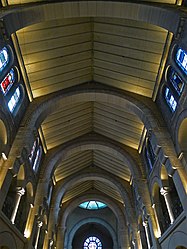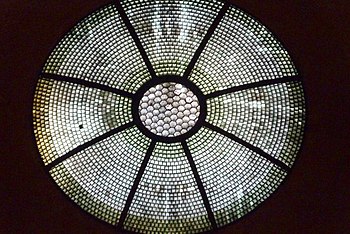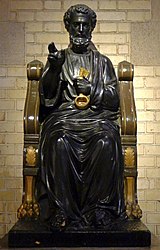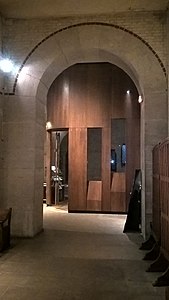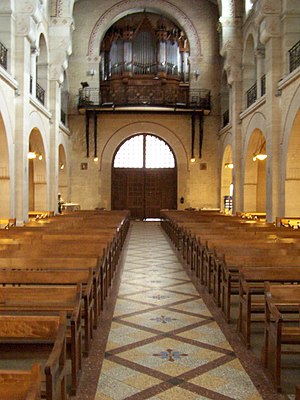
The Church of Saint-Germain-des-Prés is a Roman Catholic parish church located in the Saint-Germain-des-Prés quarter of Paris. It was originally the church of a Benedictine abbey founded in 558 by Childebert I, the son of Clovis, King of the Franks. It was destroyed by the Vikings, rebuilt, and renamed in the 8th century for Saint Germain, a 6th century bishop. It was rebuilt with elements in the new Gothic style in the 11th century, and was given the first flying buttresses in the 12th century. It is considered the oldest existing church in Paris.

The Church of St. Eustache, Paris, is a church in the 1st arrondissement of Paris. The present building was built between 1532 and 1633.

The Church of Saint-Germain l'Auxerrois is a medieval Roman Catholic church in the 1st arrondissement of Paris, directly across from the Louvre Palace. It was named for Saint Germanus of Auxerre, a medieval bishop of Auxerre, who became a papal envoy and met Saint Genevieve, the patron saint of Paris, on his journeys. Genevieve is reputed to have converted queen Clotilde and her husband, French king Clovis I to Christianity at the tomb of Saint Germain in Auxerre.

The Church of Saint-Séverin is a Roman Catholic church in the 5th arrondissement, or Latin Quarter, of Paris, on the lively tourist street Rue Saint-Séverin. It was constructed beginning in 1230, then, after a fire, rebuilt and enlarged in the 15th to 17th centuries in the Flamboyant Gothic style. It was the parish church for students at the University of Paris, and is one of the oldest churches that remains standing on the Left Bank.

The Église de la Sainte-Trinité is a Roman Catholic church located on the place d'Estienne d'Orves, at 3 rue de la Trinité, in the 9th arrondissement of Paris. It was built between 1861 and 1867 during the reign of Emperor Napoleon III, in the residential neighborhood of the Chaussée d'Antin. It is in the ornate Neo-Renaissance or Second Empire Style, with a highly visible 65-meter-tall belfry.

The Church of Saint-Merri or Église Saint-Merry) is a parish church in Paris, located near the Centre Pompidou along the rue Saint Martin, in the 4th arrondissement on the Rive Droite. It is dedicated to the 7th century abbot of Autun Abbey, Saint Mederic, who came to Paris on pilgrimage and later died there in the year 700. In 884 Mederic was declared patron saint of the Right Bank.

The Basilica of Saint Clotilde is a basilica church located on the Rue Las Cases, in the 7th arrondissement of Paris. It was constructed between 1846 and 1856, and is the first example of a church in Paris in the neo-Gothic style.

Saint-Louis en l'Île is a Roman Catholic parish church located at 19 Rue Saint-Louis en l'Île on Île Saint-Louis in the 4th arrondissement of Paris, France. It was constructed between 1664 and 1725, and is dedicated to King Louis IX of France, or Saint Louis. The church was originally built in the French Baroque style of the 17th century, but much of the interior decoration was taken or destroyed in the French Revolution. The church was extensively restored and redecorated in the 19th century.

Joseph Auguste Émile Vaudremer was a French architect. He won the prix de Rome and designed several public buildings in France, particularly in Paris, four of which have been designated monuments historiques.

Saint-Laurent is a Catholic church in the 10th arrondissement of Paris at 68 bis Boulevard de Magenta. A series of churches occupied the site since the 10th century. It is named for Saint Lawrence, an early Christian martyr who was executed in Rome by the Roman Emperor Valerian in 258 AD. It has been listed since 2016 as a monument historique by the French Ministry of Culture.

The Église Saint-Paul-Saint-Louis is a church on rue Saint-Antoine in the Marais quarter of Paris. The present building was constructed from 1627 to '41 by the Jesuit architects Étienne Martellange and François Derand, on the orders of Louis XIII of France. It was the first church in Paris to break away entirely from the Gothic style and to use the new Baroque style of the Jesuits, and it had an important influence on Parisian religious architecture. It gives its name to Place Saint-Paul and its nearest Metro station, Saint-Paul. Next door to the church is the Lycée Charlemagne, also founded by the Jesuits.

Notre-Dame des Blancs-Manteaux is a Roman Catholic parish church at 12 Rue des Blancs-Manteaux in Le Marais, in the 4th arrondissement of Paris. It takes its name from the "Les Blancs-Manteaux", for the cloaks worn by the mendicant Augustinian Order of Servites, who founded the first church 1258. It was rebuilt between 1685 and 1689 in the French Baroque or French neoclassical style. It is noted for its remarkable carved wood pulpit (1749) and its collection of paintings and sculpture.

Saint-Jacques du Haut-Pas is a Roman Catholic parish church in Paris, France. The church is located at the corner of Rue Saint-Jacques and Rue de l'Abbé de l'Épée in the 5th arrondissement of Paris. The first church on the site, a monastery chapel, was built in 1360. The present church was completed in 1685. The church is named for Saint-Jacques Du-Haut-Pas,", a cousin of Christ and the first bishop of Jerusalem, who was martyred in the year 60. It was registered as an historical monument on 4 June 1957.

Notre-Dame de Clignancourt is a Roman Catholic church located in the 18th arrondissement of Paris. Completed in 1863, the church takes its name from Clignancourt, a small village in the commune of Montmartre that was annexed to Paris in 1860. It was one of three new parishes created to accommodate the growing population in the northern edge of the city.

Saint-Pierre de Chaillot is a Roman Catholic parish church in the Chaillot neighborhood of the 16th arrondissement of Paris, at 31, avenue Marceau. It is constructed in the "Romano-Byzantine" style.

Notre-Dame-de-la-Croix de Ménilmontant is a Roman Catholic parish church located at Place Ménilmontant, in the 20th arrondissement of Paris, France. It was built between 1863 and 1880. Of exceptional height and length, it is one of the largest churches in Paris.

Église Saint-Eugène-Sainte-Cécile is a Roman Catholic church located at 6 rue Sainte-Cécile in the 9th arrondissement of Paris. In 1983 it was designated as a monument historique in its entirety. Designed in the Neo-Gothic style by Louis-Auguste Boileau and Louis-Adrien Lusson, the church was the first in France to use an entirely iron-framed construction. The first stone was laid in 1854, and the building was completed in 1855.

Ledru-Rollin Avenue is a street situated in the neighbourhoods of Quinze-Vingts of the 12th arrondissement and Sainte-Marguerite and Roquette of the 11th arrondissement of Paris.

Notre-Dame-de-la-Compassion is a Roman Catholic Church located on Place du Général Koenig in the 17th arrondissement in Paris. It was originally built in 1842–43 as a memorial chapel to Ferdinand Philippe, Duke of Orléans, the heir to King Louis-Philippe of France, who was killed in a road accident in 1842. It was built in the Neo-Byzantine style, with elements of Gothic, Baroque and other styles, and was originally called the Chapelle Royale Saint-Ferdinand. In 1970 it was moved stone by stone from its original location a short distance away to make space for the new Palais des Congrès. It became a parish church in 1993. Its notable decoration includes stained glass windows designed by Jean-Auguste-Dominique Ingres, and sculpture by Henri de Triqueti. It was designated a French historic monument in 1929.







